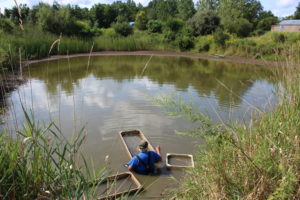
After suffering production losses in 2016, Sanford contacted his local FSA office and learned about the Emergency Assistance for Livestock, Honeybees and Farm-Raised Fish Program (ELAP).
By Lynnette Wright, FSA Public Affairs Specialist, New York
Challenging weather hit upstate New York hard in the summer of 2016. Extreme heat, coupled with one of the worst droughts in recorded history, brought many impacted producers to the Farm Service Agency (FSA) for disaster assistance, including owners of a walleye fish farm.
Sanford’s Bait Farm is located in Wolcott, New York, about 40 miles east of Rochester. Stephen Sanford has been farming fish for over 30 years. One of his main “crops” is walleyed pike, a member of the perch family. Walleye fishing is a popular hobby in upstate New York. The fish are flakey, firm with few bones and are sought after by many upstate New York restaurants.
Sanford starts his walleye production with growing the fry, a recently hatched fish, in ponds. The fish grow until they are about three to five inches long and have developed stripes on their back, signifying the fish are large enough to sell to stock lakes, rivers and reservoirs around New York. These fish will grow to over 30 inches long.
Walleye prefer cool waters, so in the summer of 2016, most of Sanford’s fish died due to excessive heat. The fish couldn’t find cool enough water to survive.
With no crop to sell and bills coming in, Sanford didn’t know how to keep his farm going. He turned to his local FSA county office and learned his walleye fish losses were eligible for the Emergency Assistance for Livestock, Honeybees and Farm-Raised Fish Program (ELAP). This program provides emergency assistance to eligible producers of farm-raised fish, as well as livestock and honeybees, and covers losses due to an eligible adverse weather or loss condition, including excessive heat.
“Mr. Sanford had not participated with FSA before the disaster. He has farmed for more than 30 years and has never lost virtually all his fish, until the summer of 2016,” said Denise Buisch, a Wayne County FSA Program Technician.
In the summer of 2017, Sanford was back in business and back doing what he loves, sorting walleye in his ponds.
“I wouldn’t have been able to keep farming without the Farm Service Agency and the ELAP payment we received. I was out of options,” he said. “I’ve worked hard all of my life and we’ve never had a year as bad as that. We lost so much money, I don’t know what we would have done without FSA.”
For more information about ELAP, contact your local FSA office or visit www.fsa.usda.gov. To find your local FSA office, visit http://offices.usda.gov.





